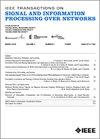基于时间顶点自适应滤波器的在线图拓扑学习:从理论到心脏纤颤
IF 3
3区 计算机科学
Q2 ENGINEERING, ELECTRICAL & ELECTRONIC
IEEE Transactions on Signal and Information Processing over Networks
Pub Date : 2025-08-06
DOI:10.1109/TSIPN.2025.3594003
引用次数: 0
摘要
图形信号处理(GSP)通过将数据建模为图形上的信号,为分析复杂、相互关联的系统提供了一个强大的框架。虽然最近的进展使图拓扑能够从观察到的信号中学习,但现有的方法往往难以适应时变系统和实时应用。为了解决这一差距,我们引入了AdaCGP,一种基于多变量时间序列的动态图拓扑估计的稀疏感知自适应算法。AdaCGP通过设计用于解决稀疏性、移位不变性和偏差的递归更新公式来估计图移位算子(GSO)。通过全面的模拟,我们证明了AdaCGP在不同的图拓扑中始终优于多个基线,与最先进的方法相比,GSO估计的改进超过83%,同时保持了有利的计算缩放特性。我们的变量分裂方法能够可靠地识别具有接近零误报率和最小漏边的因果关系。应用于心脏颤动记录,AdaCGP比现有方法(如格兰杰因果关系)更有效地跟踪传播模式的动态变化,捕获静态方法无法捕获的图拓扑的时间变化。该算法成功识别可能维持心律失常的传导模式的稳定性特征,展示了在复杂生物医学系统诊断和治疗中的临床应用潜力。本文章由计算机程序翻译,如有差异,请以英文原文为准。
Online Graph Topology Learning via Time-Vertex Adaptive Filters: From Theory to Cardiac Fibrillation
Graph Signal Processing (GSP) provides a powerful framework for analysing complex, interconnected systems by modelling data as signals on graphs. While recent advances have enabled graph topology learning from observed signals, existing methods often struggle with time-varying systems and real-time applications. To address this gap, we introduce AdaCGP, a sparsity-aware adaptive algorithm for dynamic graph topology estimation from multivariate time series. AdaCGP estimates the Graph Shift Operator (GSO) through recursive update formulae designed to address sparsity, shift-invariance, and bias. Through comprehensive simulations, we demonstrate that AdaCGP consistently outperforms multiple baselines across diverse graph topologies, achieving improvements exceeding 83% in GSO estimation compared to state-of-the-art methods while maintaining favourable computational scaling properties. Our variable splitting approach enables reliable identification of causal connections with near-zero false alarm rates and minimal missed edges. Applied to cardiac fibrillation recordings, AdaCGP tracks dynamic changes in propagation patterns more effectively than established methods like Granger causality, capturing temporal variations in graph topology that static approaches miss. The algorithm successfully identifies stability characteristics in conduction patterns that may maintain arrhythmias, demonstrating potential for clinical applications in diagnosis and treatment of complex biomedical systems.
求助全文
通过发布文献求助,成功后即可免费获取论文全文。
去求助
来源期刊

IEEE Transactions on Signal and Information Processing over Networks
Computer Science-Computer Networks and Communications
CiteScore
5.80
自引率
12.50%
发文量
56
期刊介绍:
The IEEE Transactions on Signal and Information Processing over Networks publishes high-quality papers that extend the classical notions of processing of signals defined over vector spaces (e.g. time and space) to processing of signals and information (data) defined over networks, potentially dynamically varying. In signal processing over networks, the topology of the network may define structural relationships in the data, or may constrain processing of the data. Topics include distributed algorithms for filtering, detection, estimation, adaptation and learning, model selection, data fusion, and diffusion or evolution of information over such networks, and applications of distributed signal processing.
 求助内容:
求助内容: 应助结果提醒方式:
应助结果提醒方式:


